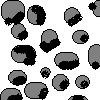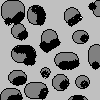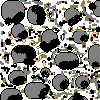Aggregate structure
The structure of a soil (the structure) can be divided into three groups according to the cohesion of the soil particles - with transitional forms. In addition to the single grain structure or elementary structure of independent soil particles (typically sand) and the coherent structure - a bonded mass (typically clay sediment ) - exists as a third group, the aggregate structure (Latin aggregare: pile) - including building structure or crumb structure of rich topsoils with strong biological Activity.
By dividing forces in the event of shrinkage, cracking, and the effects of frost, fine-grain mineral soil particles continue to form so-called segregate structures , for example polyhedron structures in clay soils with inhibited biological activity.
Coherent structure (or special form of cement structure )
Polyhedron structure, as a variant of the Segregat structure
Assembled soil particles (aggregates) are:
- 'Crumbs' with a diameter of 1 to 10 mm, they are rounded, humic and very porous.
- 'Crumbles' are like crumbs, but larger than 10 mm in diameter.
This heterogeneous aggregate structure arises in the case of advanced soil development in the A h horizon due to the effects of frost (frost bake), mixing processes ( turbation ), soil organisms and as a result of suitable soil cultivation in cultivated soils.
Adhered soil particles, humus particles and single grains form more or less stable crumbs, which are coupled together as lime-clay-humus complexes through mixed coagulation ( cement structure ). The bond takes place via polyvalent cations, mainly Ca ++ and Mg ++ , as well as water and organic dipoles with OH bridges.
Aggregate structures are isolated, have different causes and different shapes. A distinction is made on the basis of the following under ab and c. mentioned mark:
- A. 'Structure' created by biological activity
- 1. worming structure
- a. high stability
- b. Formation of clay-humus complexes (THK)
- c. Live shoring by the earthworm
- 2. Crumb structure
- a. very porous
- b. high stability (THK, living shoring)
- c. Technically optimal
- 1. worming structure
- For example, by shrinkage resulting isolation structure
- 1. Polyhedral structure
- a. sharp edges
- b. poor stability
- 2. Plate structure
- a. stored horizontally
- b. Plow or milling base
- c. Paths, lanes (compaction)
- 1. Polyhedral structure
- C. resulting from tillage fragment structure
- 1. Crumble
- a. Tillage in optimal condition
- 2. Lump
- a. Cultivation of the soil when the condition is too wet or too dry
- 1. Crumble
See also
- Soil structure
- Bottom cooking
- Pore volume
- Cation exchange capacity
- Liming
- humus
- Melioration
- Soil fertility
literature
- Karl-Heinrich Hartge : Introduction to soil physics , p. 33, Stuttgart 1978 ISBN 3-432-89681-6
- Diedrich Schroeder : Soil Science in Key Words , Unterägeri 1984, p. 62, ISBN 3-266-00192-3



